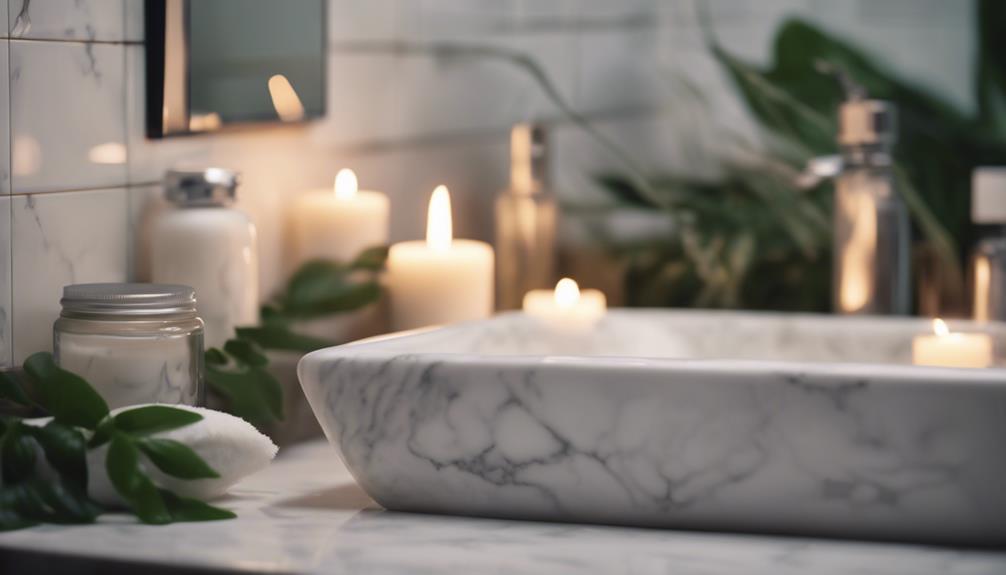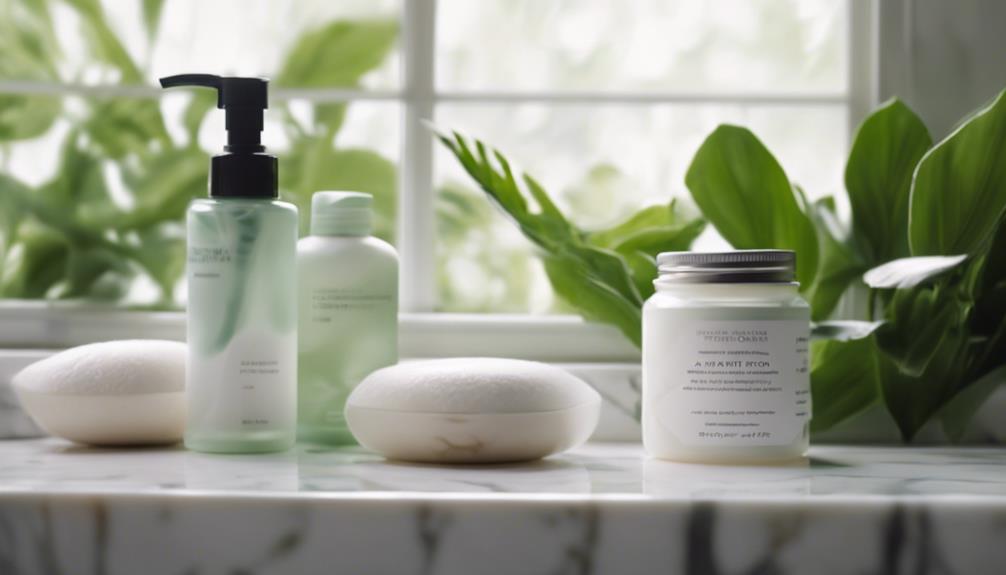To address fungal acne, begin by using a mild antifungal cleanser with ketoconazole or pyrithione zinc. Exfoliating with salicylic acid 1-3 times per week can help clear dead skin and prevent breakouts. Keep your skin hydrated with lightweight, oil-free moisturizers to avoid pore blockages. Remember to apply broad-spectrum sunscreen daily to shield against UV damage, being cautious with heavy formulas that could exacerbate breakouts. Consistently follow antifungal treatments for long-lasting results and prioritize good hygiene practices, such as regularly washing your towels. By adhering to these guidelines, you can achieve balanced skin, reduce breakouts, and discover more tips along your skincare journey.
Key Takeaways
- Use a gentle antifungal cleanser containing ketoconazole or pyrithione zinc to target Malassezia yeast effectively.
- Exfoliate 1-3 times a week with salicylic acid to remove dead skin cells and prevent clogged pores.
- Apply a lightweight, oil-free moisturizer with hyaluronic acid to maintain hydration and support the skin barrier.
- Incorporate a broad-spectrum sunscreen with at least SPF 30 daily to protect against UV damage without clogging pores.
Understanding Fungal Acne
Fungal acne, also known as pityrosporum folliculitis, occurs when there's an overgrowth of Malassezia yeast, leading to small, itchy bumps on your skin.
Unlike traditional acne, fungal acne often appears on your chest, back, and face, presenting as uniform red bumps without whiteheads or blackheads.
Understanding its causes is essential for managing your condition effectively.
A compromised skin barrier can make you more susceptible to fungal acne. Factors like high humidity, excessive sweating, and the use of occlusive skincare products can contribute to this overgrowth.
To keep your skin in check, you need to focus on fungal acne-safe products. Look for those that contain gentle antifungal ingredients like ketoconazole or pyrithione zinc, as these can effectively combat the Malassezia yeast without aggravating your skin.
Importance of a Skincare Routine
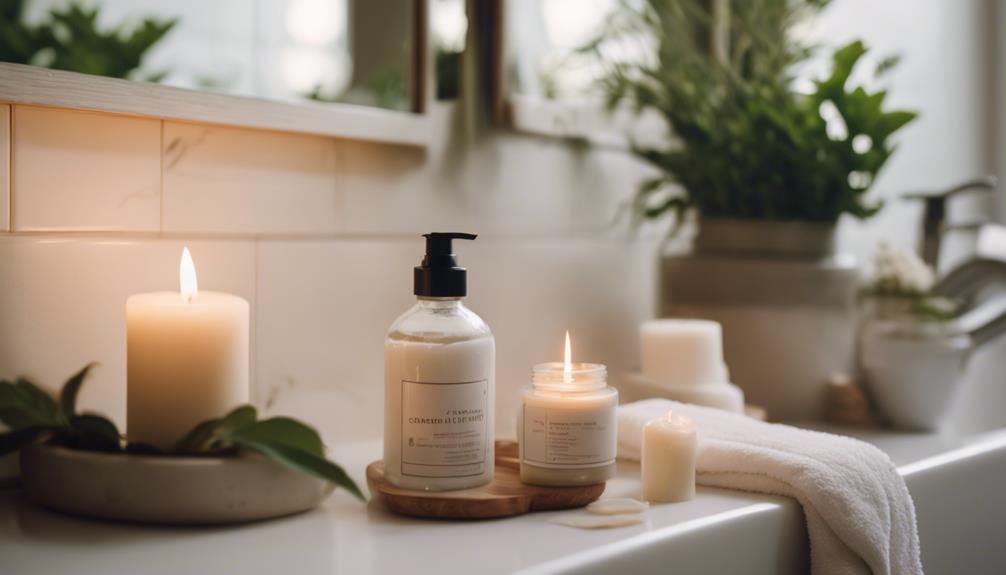
A consistent skincare routine plays an essential role in managing fungal acne by helping to balance your skin's microbiome and reduce malassezia overgrowth. By incorporating cleansing and toning steps, you can effectively target the yeast responsible for breakouts. Choose a gentle, antifungal cleanser, like those containing ketoconazole or pyrithione zinc, to keep your skin clear without causing irritation.
Regular exfoliation is also important; using salicylic acid products helps remove dead skin cells and unclog pores, minimizing the chances of future flare-ups.
Don't forget to keep your skin hydrated. Lightweight, oil-free moisturizers are ideal for supporting your skin barrier while preventing dehydration, which can exacerbate fungal acne.
Sun protection is another vital aspect of your routine. Opt for broad-spectrum SPF that's non-comedogenic to avoid aggravating your skin.
Choosing the Right Cleanser
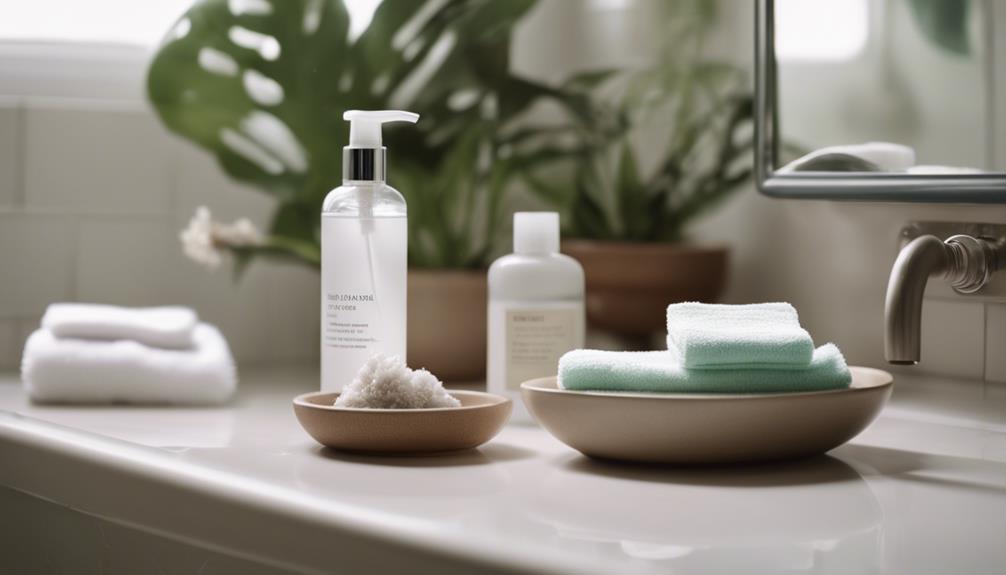
Finding the right cleanser is crucial for effectively managing malassezia overgrowth and keeping fungal acne at bay. You should look for a gentle antifungal cleanser that contains active ingredients like ketoconazole or pyrithione zinc. These ingredients specifically target the yeast responsible for your breakouts. Avoid foaming or sudsy cleansers, as they disrupt your skin's pH and can worsen the issue.
To help you choose the best options, here's a quick comparison:
| Cleanser Type | Notes |
|---|---|
| Gentle Antifungal | Look for ketoconazole or pyrithione zinc. |
| pH Balanced | Confirm it's labeled as 'pH balanced.' |
| Non-Medicated Option | Use alongside antifungal cleansers. |
| Example Product | Dr. Eddie's Happy Cappy (0.95% pyrithione) |
| Rinsing Tips | Always rinse with lukewarm water. |
Regularly assess your skin's response to different cleansers and adjust your routine accordingly. This approach will help you effectively cleanse your skin without causing irritation or compromising your skin barrier.
Exfoliation Techniques

Incorporating effective exfoliation techniques into your skincare routine can greatly enhance your efforts to manage fungal acne by clearing away dead skin cells that clog pores. For this skin condition, consider using chemical exfoliants like salicylic acid.
Unlike physical scrubs, these chemical options penetrate the skin to unclog pores and reduce inflammation, making them more suitable for your needs. Aim to exfoliate 1-3 times a week, adjusting based on your skin sensitivity. Over-exfoliating can irritate your skin and compromise its barrier, leading to more issues.
After exfoliation, it's beneficial to apply a soothing toner with calming ingredients such as green tea or chamomile. This can help alleviate redness and irritation associated with fungal breakouts.
Always remember to follow up your exfoliation with proper hydration. Use lightweight, oil-free moisturizers that support your skin barrier without encouraging fungal overgrowth.
Hydration and Moisturization
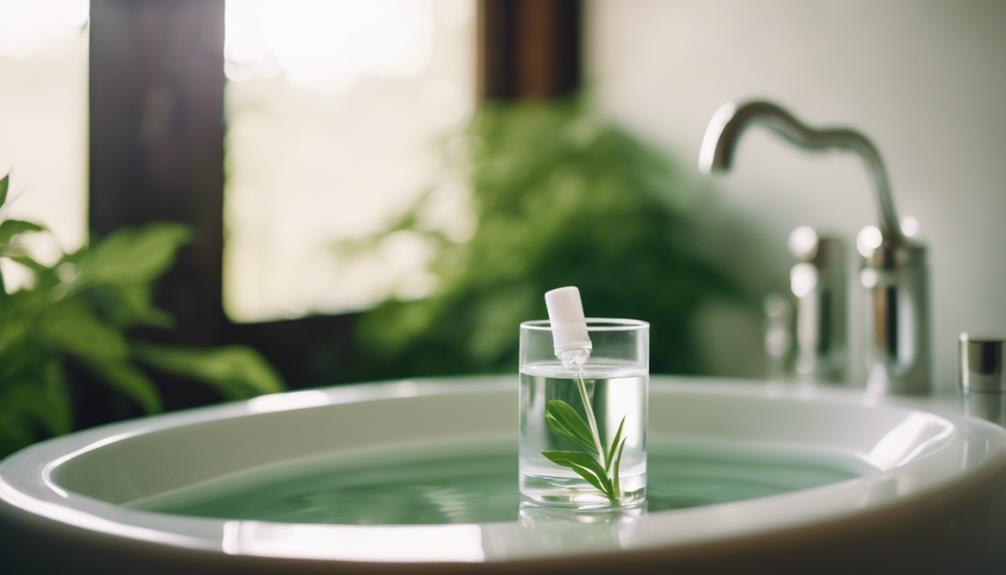
When you're managing fungal acne, hydration plays a key role in keeping your skin barrier healthy.
Opt for lightweight, oil-free moisturizers with ingredients like hyaluronic acid and ceramides to provide moisture without aggravating the condition.
Importance of Hydration
Hydration plays an essential role in maintaining your skin's barrier, helping to prevent moisture loss and reduce the risk of fungal acne flare-ups. When your skin is well-hydrated, it can regulate oil production more effectively, creating an environment less conducive to malassezia overgrowth.
Incorporating hydrating products into your routine, like serums with hyaluronic acid, can greatly boost moisture levels without adding oils that might worsen your condition. You should also consider using mineral sprays, especially in humid conditions where your skin may lose moisture quickly.
These products can help replenish hydration throughout the day, keeping your skin plump and healthy. Don't forget that drinking adequate water daily is crucial too; it supports overall skin health by flushing out toxins and maintaining moisture levels.
Lightweight Moisturizers Recommended
Using lightweight, oil-free moisturizers is essential for keeping your skin hydrated without triggering fungal acne flare-ups.
These moisturizers provide the necessary hydration while avoiding ingredients that feed Malassezia yeast, which can worsen your condition. Look for options that contain hydrating properties like hyaluronic acid, urea, and ceramides. These ingredients not only hydrate but also help maintain your skin barrier's integrity.
It's vital to choose non-comedogenic moisturizers to prevent clogged pores, which can exacerbate fungal acne symptoms.
Products like Daily Mineral Spray and Stress Less Hydrating & Repairing Serum are excellent choices as they offer hydration without the heaviness that can lead to breakouts.
Ingredients for Skin Barrier
Maintaining a healthy skin barrier requires incorporating effective ingredients that hydrate and moisturize without aggravating fungal acne. Hydration is essential, as it prevents dehydration and supports overall skin health.
Lightweight, oil-free moisturizers with hyaluronic acid, ceramides, and urea are excellent choices, providing moisture while keeping fungal growth at bay. You can also enhance hydration by using a mineral spray, like Daily Mineral Spray, which is non-comedogenic and suitable for your skin type.
Additionally, incorporating soothing ingredients such as aloe vera and green tea will calm inflammation and promote skin barrier recovery.
Don't forget to regularly apply a hydrating serum, such as the Stress Less Hydrating & Repairing Serum, to further boost moisture levels. This not only strengthens your skin barrier but also protects against external aggressors.
Antifungal Treatments
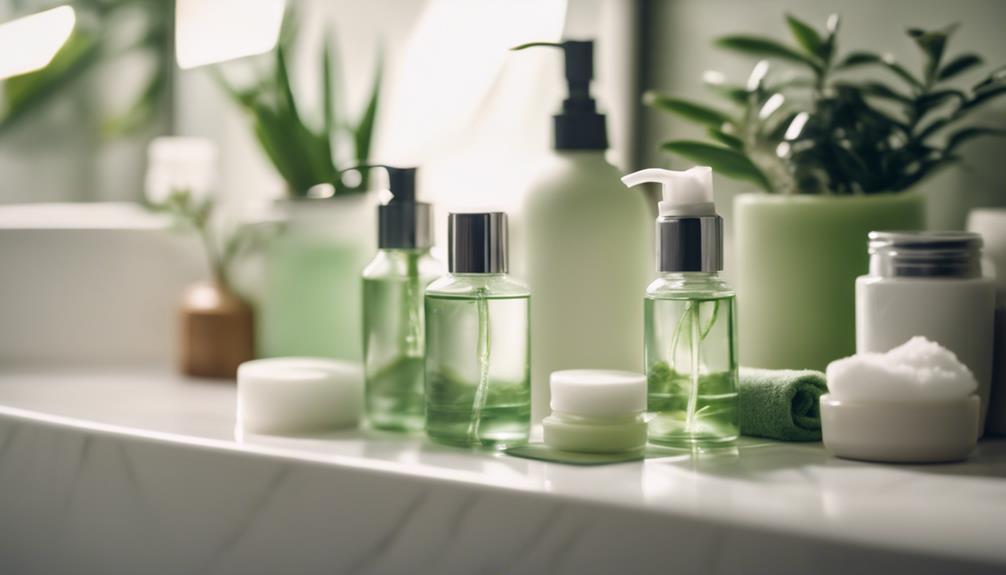
Antifungal treatments, like creams and serums with ketoconazole or tea tree oil, effectively target the Malassezia yeast that causes fungal acne. These ingredients are vital in your skincare routine to combat breakouts. Over-the-counter options, such as Nizoral AD, can be incorporated daily for best results.
For ideal effectiveness, you'll want to apply these antifungal treatments consistently, often requiring daily use for several weeks. This commitment is essential to see significant improvement in your skin. Pairing these treatments with a gentle skincare routine is equally important. Use non-medicated cleansers and lightweight moisturizers to avoid irritation and support your skin's recovery process.
If you find that over-the-counter antifungal treatments aren't working as expected, it's important to consult a dermatologist. They can provide personalized solutions tailored to your specific needs, ensuring you're on the right track to clearer skin.
Sun Protection Strategies

To effectively manage fungal acne, incorporating sun protection strategies into your skincare routine is essential for preventing further irritation and inflammation.
Start by using a broad-spectrum sunscreen with at least SPF 30. This protects your skin from harmful UV rays that can worsen your fungal acne. Look for non-comedogenic sunscreens to avoid clogged pores and additional breakouts. Products like TiZO3 Facial Sunscreen are specifically designed to be gentle on sensitive skin.
Make it a habit to apply sunscreen daily, even when it's cloudy, since UV rays can still penetrate through the clouds and cause skin damage. Reapply your sunscreen every two hours, especially after sweating or swimming, to maintain consistent protection. This is vital for keeping your skin healthy while managing fungal acne.
Incorporate sunscreen into your morning skincare routine after applying antifungal treatments. This helps create a protective barrier without compromising the effectiveness of your acne treatments.
Lifestyle and Dietary Factors
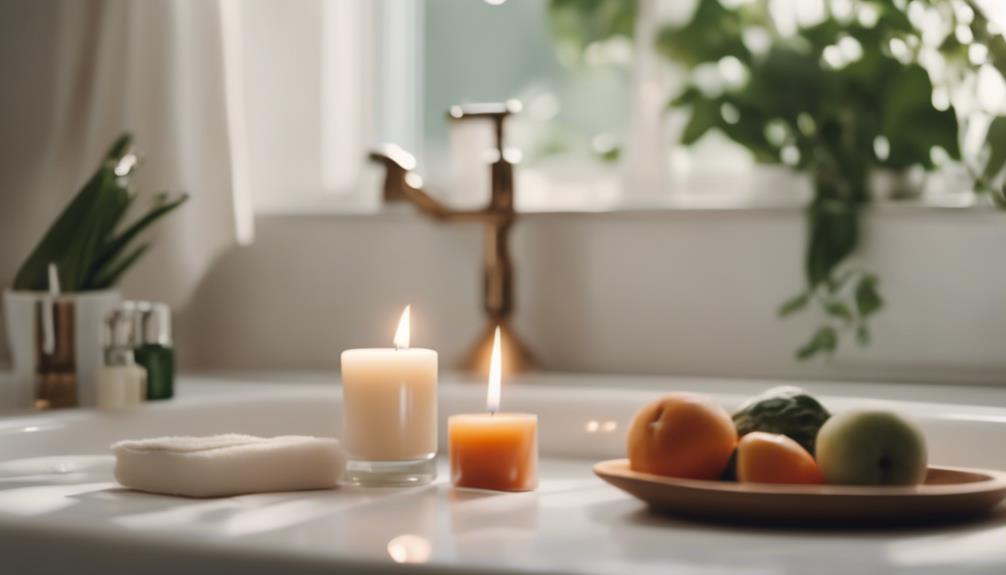
A balanced diet and healthy lifestyle can greatly influence your skin's ability to fight fungal acne. Focus on incorporating a variety of fruits, vegetables, and lean proteins into your meals. These dietary factors provide essential nutrients that support skin health and may help minimize breakouts.
Staying hydrated is equally important; adequate water intake flushes out toxins and keeps your skin moisturized, helping you manage fungal acne more effectively.
Consider adopting a low glycemic load diet to regulate blood sugar levels. This approach can potentially shrink sebaceous glands, leading to reduced sebum production that feeds Malassezia yeast, the culprit behind fungal acne.
Additionally, don't overlook the benefits of green tea. Its sebum-regulating properties and anti-inflammatory effects make it a great addition to your diet, aiding in the fight against breakouts.
Maintaining Good Hygiene Practices
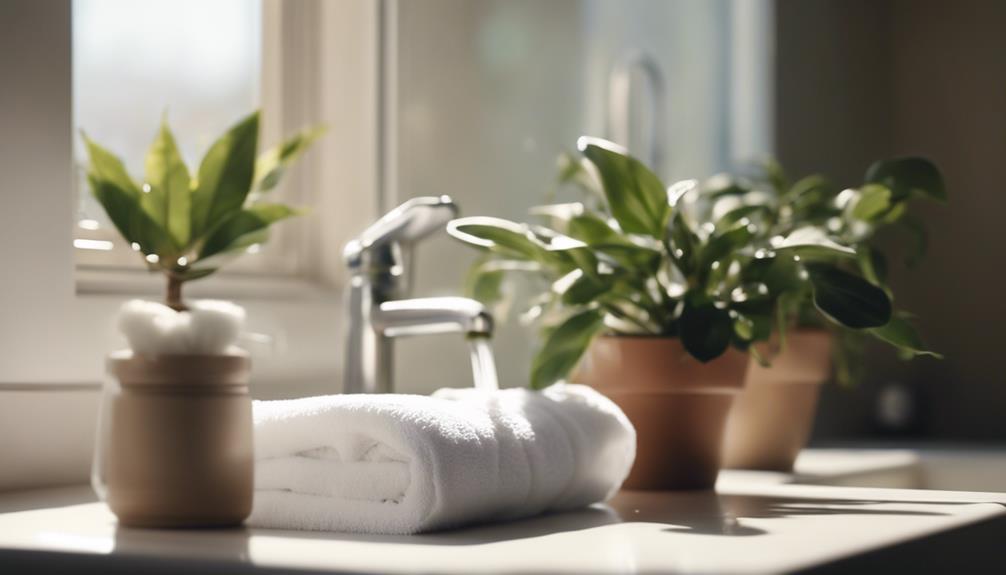
Maintaining good hygiene practices is key to controlling fungal acne and can greatly complement your healthy lifestyle choices.
Start by washing your pillowcases and towels at least once a week. This routine helps prevent fungal accumulation that could lead to flare-ups. Also, pay attention to your personal hygiene; shower after sweating or exercising to remove excess sebum and moisture that promote fungal growth.
Cleaning your makeup brushes and applicators frequently—ideally every week—is essential. This prevents cross-contamination and stops malassezia yeast from transferring onto your skin.
When it comes to makeup, avoid heavy and occlusive products that can trap moisture, opting instead for non-comedogenic and oil-free cosmetics.
Can the Fungal Acne Skincare Routine also Help with Hormonal Acne Breakouts?
If you’re struggling with both fungal acne and hormonal acne breakouts, incorporating specific hormonal acne skincare tips into your routine can be beneficial. Look for products containing salicylic acid or benzoyl peroxide to target hormonal breakouts, while still following a fungal acne skincare routine to maintain balance and clarity in your skin.
Conclusion
Managing fungal acne can feel overwhelming, but with the right routine, you can achieve clear skin.
Balance gentle cleansing with effective exfoliation; hydrate without clogging pores.
Combine antifungal treatments with sun protection for a thorough approach.
While lifestyle choices might tempt you, staying disciplined pays off.
Embrace good hygiene practices to keep breakouts at bay.
Remember, consistency is key—what you do today shapes your skin tomorrow.
With patience and care, radiant skin is within reach.

